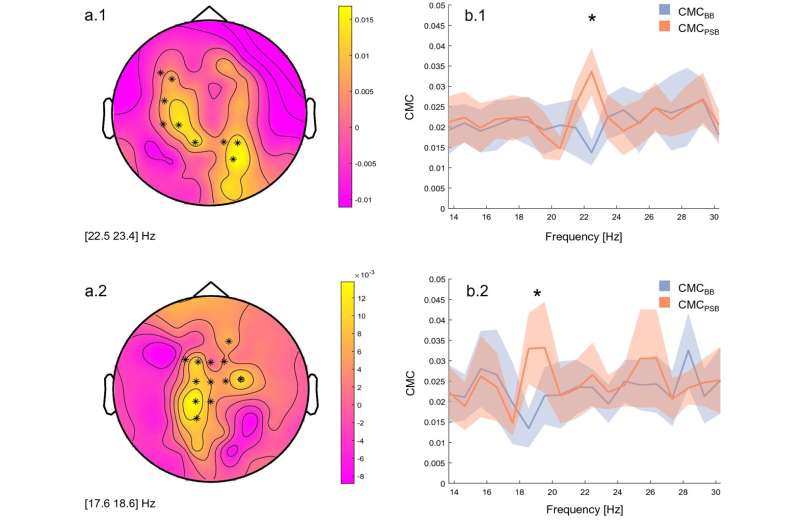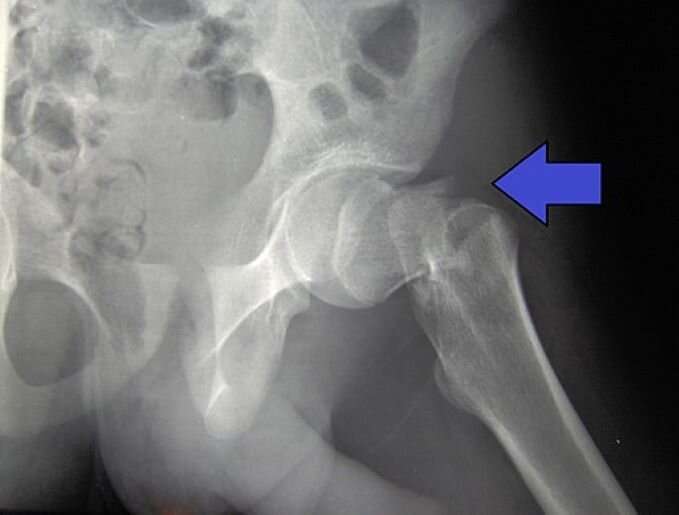Corticomuscular coherence topographic maps and spectra. On the left-side, voltage topographic maps of the difference between EMG-EEG couplings before and EMG-EEG couplings after the WBVs (CMCBB and CMCPSB, respectively), averaged across subjects, are reported for the right GL (a.1) and the right SOL (a.2). The asterisks depict electrodes that showed a significantly bigger CMC around 23 Hz (a.1) and 19 Hz (a.2). On the right-side, CMC spectra (mean ± standard error) of EMG-EEG couplings before and after the stimulation are reported for the right GL (b.1) and the right SOL (b.2). The asterisks depict the frequency bin at which the CMC signals differed between conditions, as identified by the cluster-based permutation test. Results are shown for CMC vectors obtained from the 45 s-long baseline (BB) and post-stimulation (PSB) trials. Credit: Scientific Reports (2023). DOI: 10.1038/s41598-022-27117-7
Mechanical vibrations could help improve our muscles and our balance control, according to research at Aston University.
Researchers in the College of Engineering and Physical Sciences have examined the effect of stimulation on muscle spindles which "speak" to the central nervous system to help keep us upright and walk straight.
Their results provide new perspectives on whole-body vibration applications, paving the way for future research on the interaction between the central nervous system and the peripheral muscles.
The research could in the future be applied to improve balance in older people and help reduce falls, this could be applied through either wearable devices or with a daily session of stimulation. Hip fractures alone account for 1.8 million hospital bed days and £1.1 billion (approximately $1.3 billion) in hospital costs every year, excluding the high cost of social care.
Another potential benefit of the research is that this type of stimulation could be applied to athletes to decrease their muscle reaction times.
The goal of the study was to find out if mechanical vibrations can improve the way our bodies process and react to small body oscillations.
Cdm hip fracture 343. Credit: Booyabazooka/Wikimedia Commons, CC BY-SA 3.0
Seventeen young male and female adult volunteers aged between 20 and 28 years old stood individually on platforms, similar to vibrating plates found in gyms, which caused leg muscle contractions. Calf muscles were targeted as the muscles whose action contribute the most to maintaining a stable upright posture.
The researchers stimulated their calves with a frequency of 30Hz and recorded four one-minute trials of undisturbed balance to take a baseline measure and compared the readings to measurements taken after the stimulation. After conducting the experiment, they found that their balance seemed to have improved.
The research, "Sensorimotor recalibration of postural control strategies occurs after whole body vibration," was led by Dr. Antonio Fratini, senior lecturer in mechanical, biomedical & design engineering, and Ph.D. student Isotta Rigoni, and has been published in Scientific Reports.
Dr. Fratini said, "We're excited by our results as they could have a beneficial effect on the health and quality of life of a large number of people.
"Our results indicate that whole body vibration challenges balance at first, triggering a bigger effort to control the upright stance and shifting muscle modulation toward supraspinal control, resulting in a recalibration of muscle recruitment. The neuromuscular system seems to recover from such disruption and regain control over a longer time interval."
"Indeed, while muscle recruitment and cortical effort appear unaltered over the long term, the balance seems not only restored but also improved, besides the still clearly affected calf muscles."
More information: Isotta Rigoni et al, Sensorimotor recalibration of postural control strategies occurs after whole body vibration, Scientific Reports (2023). DOI: 10.1038/s41598-022-27117-7
Journal information: Scientific Reports
Provided by Aston University

























